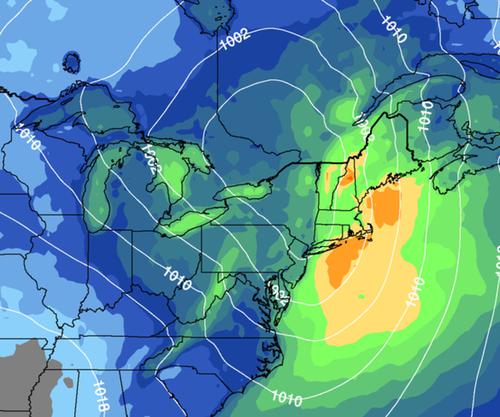当前位置:
X-MOL 学术
›
Meteorol. Appl.
›
论文详情
Our official English website, www.x-mol.net, welcomes your feedback! (Note: you will need to create a separate account there.)
Historical incidence of mid‐autumn wind storms in New England
Meteorological Applications ( IF 2.7 ) Pub Date : 2020-10-04 , DOI: 10.1002/met.1952 Julia M. Simonson 1 , Sean D. Birkel 1 , Kirk A. Maasch 1 , Paul A. Mayewski 1 , Bradfield Lyon 1 , Andrew M. Carleton 2
Meteorological Applications ( IF 2.7 ) Pub Date : 2020-10-04 , DOI: 10.1002/met.1952 Julia M. Simonson 1 , Sean D. Birkel 1 , Kirk A. Maasch 1 , Paul A. Mayewski 1 , Bradfield Lyon 1 , Andrew M. Carleton 2
Affiliation

|
New England has seen a number of mid‐autumn (October–November) wind storms—high‐wind events associated with extratropical cyclones—in recent years that have produced extensive infrastructure damage, raising concerns that these events may become more common in a changing climate. Storms developing at this time of year are unique in that they can have dominant cold‐season characteristics while also being fueled by warm‐season moisture sources (such as the remnants of tropical cyclones) or the result of an extratropical transition. To provide insights on the behavior of such storms, we explore recent storm frequency and intensity by using reanalysis and station‐based meteorological observations onward from 1979. Variables taken into consideration include 10 m wind speed, sea‐level pressure and precipitation. The results do not show a statistically significant increase in the overall frequency of mid‐autumn wind storms nor of their intensity with respect to central pressure or surface wind speeds. However, there is a statistically significant trend toward increasing precipitation accompanying wind storms with maximum 10 m wind gusts greater than 26 m⋅s−1 (58 mph). While stronger high‐wind events tend to be associated with lower central sea‐level pressure values and substantial intensification rates, other factors such as storm tracks and the pressure gradient across the New England region also affect the development and overall impact of storms. This study highlights the variety of elements, such as the background climate conditions, which could potentially increase the risk of wind damage in a warming world.
中文翻译:

新英格兰中秋风暴的历史发生率
新英格兰近年来发生了许多中秋(10月至11月)的暴风雨,这是与温带气旋有关的强风事件,造成了广泛的基础设施破坏,人们担心这些事件在气候变化的情况下可能会变得更加普遍。一年中这个时候形成的风暴是独特的,因为它们可以具有主要的寒冷季节特征,同时也可以由温暖季节的湿气源(例如热带气旋的残留物)或温带过渡的结果加剧。为了提供有关此类风暴行为的见解,我们使用1979年以来的重新分析和基于气象站的气象观测资料,探索了最近的风暴频率和强度。考虑的变量包括10 m的风速,海平面压力和降水。结果并未显示中秋暴风雨的总体频率或相对于中心压力或地表风速的强度在统计学上均显着增加。但是,在伴随最大10 m狂风大于26m⋅s的暴风雨的情况下,降水量有统计学上的显着增长趋势-1(58英里/小时)。尽管较强的强风事件往往与较低的中央海平面压力值和较大的集约化率有关,但其他因素(如风暴径和整个新英格兰地区的压力梯度)也会影响风暴的发展和整体影响。这项研究强调了各种因素,例如背景气候条件,这些因素有可能增加气候变暖带来的风灾风险。
更新日期:2020-10-05
中文翻译:

新英格兰中秋风暴的历史发生率
新英格兰近年来发生了许多中秋(10月至11月)的暴风雨,这是与温带气旋有关的强风事件,造成了广泛的基础设施破坏,人们担心这些事件在气候变化的情况下可能会变得更加普遍。一年中这个时候形成的风暴是独特的,因为它们可以具有主要的寒冷季节特征,同时也可以由温暖季节的湿气源(例如热带气旋的残留物)或温带过渡的结果加剧。为了提供有关此类风暴行为的见解,我们使用1979年以来的重新分析和基于气象站的气象观测资料,探索了最近的风暴频率和强度。考虑的变量包括10 m的风速,海平面压力和降水。结果并未显示中秋暴风雨的总体频率或相对于中心压力或地表风速的强度在统计学上均显着增加。但是,在伴随最大10 m狂风大于26m⋅s的暴风雨的情况下,降水量有统计学上的显着增长趋势-1(58英里/小时)。尽管较强的强风事件往往与较低的中央海平面压力值和较大的集约化率有关,但其他因素(如风暴径和整个新英格兰地区的压力梯度)也会影响风暴的发展和整体影响。这项研究强调了各种因素,例如背景气候条件,这些因素有可能增加气候变暖带来的风灾风险。


























 京公网安备 11010802027423号
京公网安备 11010802027423号